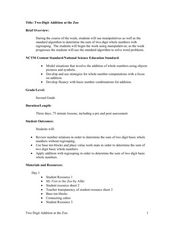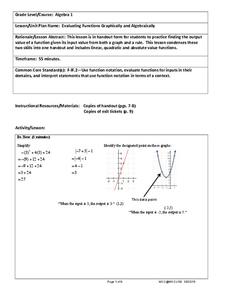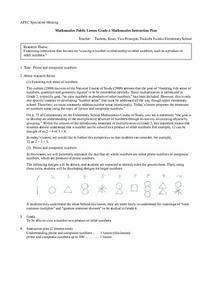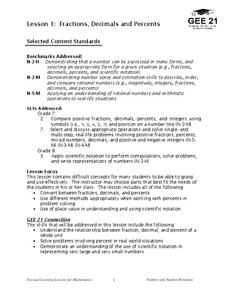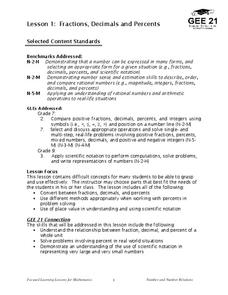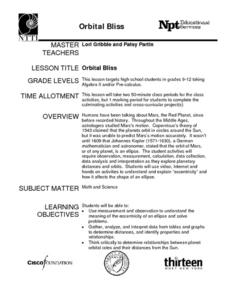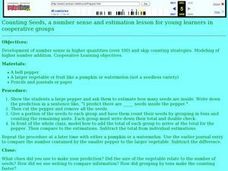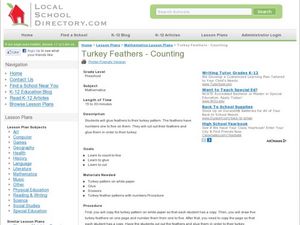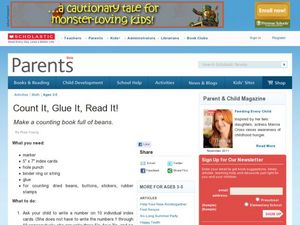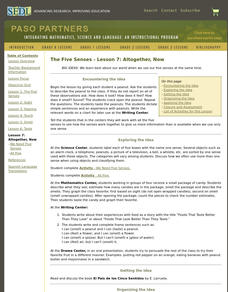EngageNY
Probability Distribution of a Discrete Random Variable
Learn how to analyze probability distributions. The sixth installment of a 21-part module teaches pupils to use probability distributions to determine the long-run behavior of a discrete random variable. They create graphs of probability...
Curated OER
Two-Digit Addition at the Zoo
Your second graders explore two digit addition with regrouping. They will investigate problem solving strategies within the context of a trip to the zoo. Multiple resources and assessments are provided.
Charleston School District
Solving Equations with Infinite or No Solutions
Where did all the variables go? Scholars learn how to interpret an equation when they eliminate all variables during the solving process. They interpret the solution as infinite solutions or no solutions.
West Contra Costa Unified School District
Shifting Linear Equations in Function Notation
Time for a shift in thinking! Learners examine translations of linear functions. They use function notation to describe the translation and make connections to the graph.
West Contra Costa Unified School District
Evaluating Functions Graphically and Algebraically
High schoolers evaluate functions graphically and algebraically. After completing that step, they write a statement describing the input and output.
Denver Public Schools
Kung-hsi Fa-ts' ai! – A Chinese New Year Celebration
Looking for ideas for your Lunar New Year celebration? Check out an interdisciplinary unit of study that includes lessons in counting, calligraphy, culture, geography, literature, art, and music. Kung-hsi Fa-ts' ai! (May you...
Curated OER
One Good Turn Deserves Another
Students make observations about shapes and 1-, 2-, and 3-dimensional objects. They conduct observations and make predictions regarding transformations of simple geometric shapes. They identify shapes that occur in household items.
Curated OER
Watershed Lesson Plan
Students are introduced to the concepts of a watershed, stream flow and water quality. This five-day plan is an excellent way to introduce students to the concepts involved. They create their own watershed using a paper bag, water and...
Curated OER
Prime And Composite Numbers - Fuzoku Elementary
Fourth graders investigate the concept of prime and composite numbers. Students study the visual representation for the numbers and use the pictures in order to develop designs for larger numbers. The goal of the lesson is for them to...
Curated OER
Fractions, Decimals and Percents
Learners investigate the differences when using decimals, fractions, and percents. They focus on the process of using them in real problems and how to convert them from one form to another.
Louisiana Department of Education
Fractions, Decimals, and Percents
Fractions, decimals, and percents all say the same thing! Show your classes how to convert between the three forms using visual and numeric representations. Then lead them to an understanding of scientific notation.
Curated OER
Orbital Bliss
Most young mathematicians are aware that the planets don’t orbit the sun in a circle but rather as an ellipse, but have never studied this interesting feature. This resource looks at the planetary orbits in more detail and helps learners...
Curated OER
Positive and Negative Numbers
Pupils use blocks and markers to illustrate the processes of adding, subtracting, multiplying and dividing integers. In this mathematics lesson plan, learners use Algebra blocks to demonstrate multiplying polynomials.
Georgia Learning Connections
Stand By Me!
Get your little mathematicians moving with this experiential activity in which one child is the "tens" and another is the "ones." They collect the number of unifix cubes (in tens or singles) assigned to their respective place values and...
Curated OER
Counting Seeds
Students practice skip counting strategies, estimation, and higher number addition. They estimate the number of seeds in bell pepper, and count seeds in groups of tens and ones after the teacher removes seeds from the pepper.
Curated OER
Fractions
Fourth graders use pattern blocks and fraction identification cards to create and identify fractions. In this fractions lesson plan, 4th graders identify fractions in a pizza, and make fractions with markers.
Ms. Amber Nakamura's Mathematics Website
Algebra Project
What would your dream house look like? A cottage? A medieval castle? High schoolers enrolled in Algebra design the perfect house while using slopes to write equations for various aspects of the project.
Curated OER
Do You Have Number Sense?
Seventh graders are grouped according to their ability level with a captain who is elected by the students in that particular group. Students demonstrate their knowledge of rational and irrational numbers by defining them. Students use a...
Curated OER
Writing and Graphing Functions
Students explore mathematics by completing a graphing assignment in class. In this math functions lesson, students practice graphing X and Y coordinates on a graph and checking their work with partners. Students complete more graphing...
Curated OER
Turkey Feathers
Students demonstrate counting skills. In this number sense lesson, students glue numbered feathers onto a turkey pattern in numerical order.
Curated OER
Math: Reasoning and Problem Solving using Voyages
Students plan a voyage as the captain of a tall ship in the early days of exploration and merchant trading. They choose 2 ships and 3 voyages for a total of 6 possibilities. They calculate the number of days and distance of their...
Curated OER
Count it, Glue it, Read it!
Students identify numbers 1-10 and count objects to match corresponding numbers. In the number sense lesson plan, students create a counting book, matching numbers they've written on index cards with the correct number of items (beans,...
Curated OER
Altogether, Now
Students apply their five senses to science, math, drama, and writing center activities.
Curated OER
Flying High
In this number sense worksheet, 2nd graders begin basic place value of ones and tens. Students complete four fill in the blank problems stating the number of groups and the total number that is shown in each picture.

